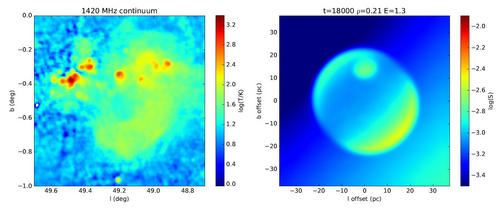MHD Simulation, a Historian and Prophet for the Evolution of SNRs
The evolution of supernova remnants (SNRs) has not been well understood for many years, and only magneto-hydrodynamics (MHD) simulations can tell us their history. Recently, by applying MHD simulation, the researchers from National Astronomical Observatories of CAS (NAOC) successfully explain the radio emission evolution of a SNR. In addition, such a simulation predicts there should be a new shell of the SNR, which is proved by the analysis of polarization observation.
A SNR is the result of the interaction between a supernova and the surrounding interstellar medium. The evolution is not only dependent on the parameters of the progenitor, but also related to the distribution of the surrounding gas and magnetic field. However, the progenitor is various and the distribution of the surrounding gas and magnetic field is also mysterious. Thus, it is very difficult to set the reasonable initial conditions. This study focuses on the SNR W51C which has been observed by various telescopes. Based on the previous work, it becomes easier to obtain appropriate conditions then realize more accurate simulation.
SNR W51C is taken as a one-edge SNR next to two HII regions, W51A and W51B. However, the simulation shows that there should be another new edge overlapping with W51A (See Fig. 1). W51A is so luminous that the new edge cannot be detected directly. In fact, many years ago, some researchers found there is non-thermal emission toward W51A which should not generate non-thermal as a HII region. This problem lasts for many years. This MHD simulation brings the first light of solving the problem. The further analysis for the polarization data of Effelsberg 100 m radio telescope in Germany shows obvious polarization emission toward W51A, which is impossible for an HII region. However, a SNR can generate both of non-thermal emission and polarization emission. This result proves the prediction of MHD simulation and solves the difficult problem.
This work also simulates the interaction between SNR W51C and a surrounding molecular cloud, explains the origin of the non-thermal emission toward a compact HII regionG49.2-0.35 in W51B, and further studies the OH maser distribution around G49.2-0.35. These results help us better understand this SNR and enrich the researches on the evolution of SNRs.
This study has been published on The Astrophysics Journal. The e-print can be accessed on arXiv :https://arxiv.org/abs/1710.04770

Fig. 1. The images of W51C. The left panel is the observed radio image, and the right panel is the image generated from the simulation. In the left panel, only the dispersive emission on the lower right was taken as SNR W51C before. The two bright regions on the upper are HII regions W51A and W51B, respectively.